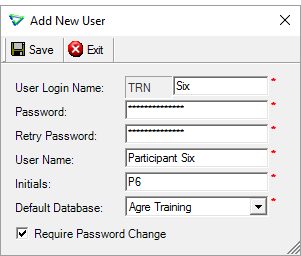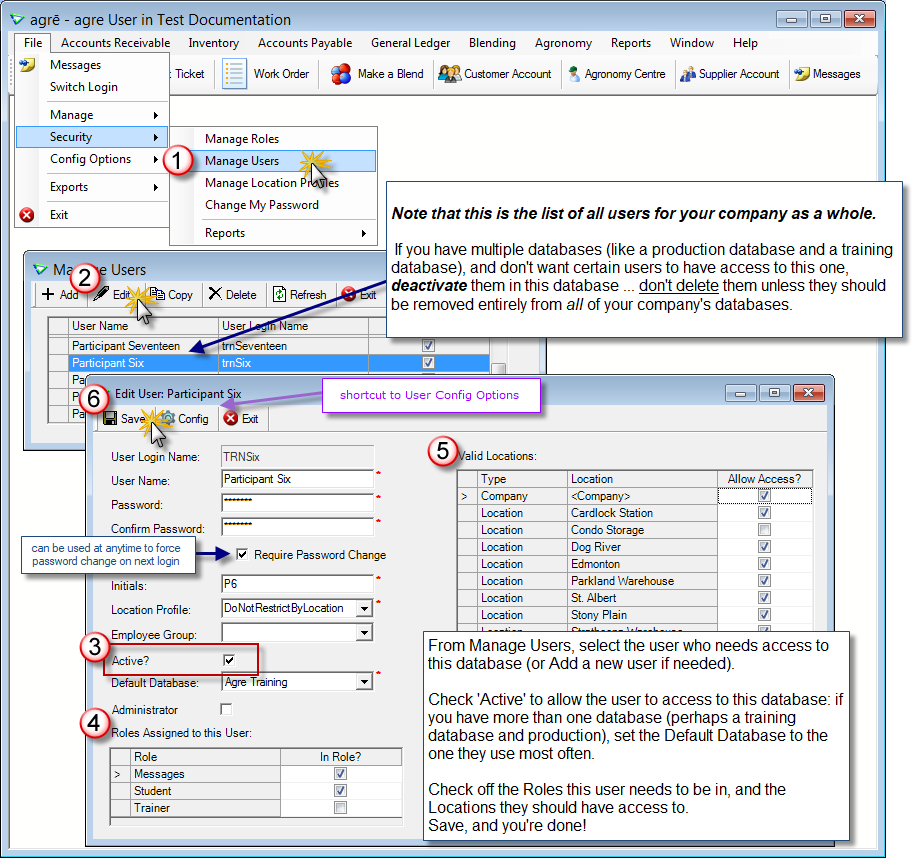Each user that you add to your agrē database is assigned to one or more roles. Users do not have security settings until you assign them to roles and they won't be able to login until you do. Users will acquire the security rights of the roles they are assigned to.
There are two steps to adding users: adding the user ID and then setting their security settings.
What you'll find:
Adding Users
You can add as many agrē users as you need.
To add a user
Navigate to File > Security > Manage Users.
Click Add.
The Add New User window opens.

Tip
You can select an existing user and Copy it to use as a 'template' for a new one.
In the User Login Name box, enter the login name you want this user to have.
This user name is used when the user logs in to agrē. Typically, the user’s first name is used as the login name.
In the Password box, enter the user’s password.
In the Retry Password box, re-enter the user’s password to confirm it.
In the User Name box, enter the user’s name (up to 50 char).
This name is the user’s name as it should appear on audit records and reports, not the user’s login name.
In the Initials box, enter the user’s initials (up to 5 characters).
Check Require Password Change if you want the user to change their password on the first login.
In the Default Database box, enter the database that you want this user to use when they login.
The user can, however, select a different database when logging in to agrē.
Click Save.
Note
After you add users, you must edit them in order to specify their security settings, roles, and location profile. Remember to check the check the Active? box so they can log in.
Adding User Security Settings
Now that you've added a user to the database, you need to specify the user’s security settings before they can login.

To specify user security settings
Navigate to File > Security > Manage Users.
From the User list, select the user to add settings to and then click Edit.
The Edit User window opens.
Tip
While managing security settings, use the Config shortcut to open their User Config Options.
If you want, you can change the user's Password, Password Change option, and Initials.
In the Location Profile box, enter the location profile that you want assigned to this user.
A location profile tells agrē if it should check the location the user has permission to for each action listed.
Select a CRM Employee Group (optional) for CRM reporting.
Ensure the Active? check box is selected.
Active is selected by default.
Select the user's Default Database.
Normally this would be your companies production database.
Check the Administrator box if you want the user to be able to:
Add and Delete other users
Delete other users' CRM and Agronomy documents
Check the Administrator box for other users
Under Roles Assigned to this User, in the In Role? column, select or clear the In Role? check boxes for the roles that you want this user to be assigned to.
Users can be assigned to one or more roles; they acquire the security rights of the roles they are assigned to.
Under Valid Locations, in the Allow Access? column, select or clear the Allow Access? check boxes for the locations that you want this user to have permission to.
The user’s location profile determines if these locations are checked.
Click Save.
Deactivating Users
Users that have had any activity in agrē can't be deleted, but you can deactivate them to prevent them from logging in again. Often seasonal user IDs are deactivated once spring is over, and reactivated next year with a new password.
Caution
All CRM Reminders for a user that is deactivated or deleted will be removed from the CRM Activity!
Before you deactivate a user you may first want to search: Accounts Receivable > CRM > CRM Activities (check the Include Inactive Employees box if the user has already been deactivated) to find any existing Reminders.
To deactivate a user
Navigate to File > Security > Manage Users.
Select the user you want to deactivate and click Edit.
The Edit User window opens.
Clear the Active? check box to deactivate the user login.
When a user is deactivated, you can still reference the user in agrē, but the user cannot login to your agrē database.
Click Save.
Deleting Users
Once you delete a user, it cannot be undone. You won't be able to delete users that have had any activity in agrē, but you can deactivate them so they can't login again.
A deleted user cannot login to any of your agrē databases.
Caution
All CRM Reminders for a user that is deactivated or deleted will be removed from the CRM Activity!
Before you delete a user you may first want to search: Accounts Receivable > CRM > CRM Activities (check the Include Inactive Employees box if the user has already been deleted) to find any existing Reminders.
To delete a user
Navigate to File > Security > Manage Users.
Select the user you want to delete and then click Delete.
Note
If the Delete button is not available, the user you selected cannot be deleted. Deactivate the user instead.
Click Yes to confirm the deletion.
The user is deleted immediately and will not be able to login to any of your agrē databases.